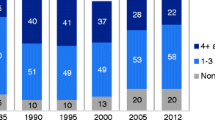Abstract
In this article we examine the relationship between extent of gambling for U.S. adults and the distance from their residence to the nearest casino or track. We employ data from a telephone survey of U.S. adults conducted in 2011–2013. The chances that the respondents gambled in the past year, were frequent gamblers, or were problem gamblers were greater if they lived close to a casino. The chances that the respondents gambled in the past year or were frequent gamblers were greater if they lived close to a horse or dog track. The effects of closeness to a casino on the likelihood of past-year gambling, frequent gambling, and problem gambling, as well as the effect of closeness to a track on past-year gambling, extended to about 30 miles from the respondent’s home. In addition, the concentration of casinos within 30 miles of the respondent’s home was positively related to the respondents’ chance of being a frequent or problem gambler. If a respondent had no casinos within 30 miles, he or she had a 2.7 % chance of being a problem gambler; if one casino, a 3.9 % chance; if six or more, a 6.2 % chance. The authors estimate that at least part of this effect is causal.
Similar content being viewed by others
References
Adams, G. R., Sullivan, A.-M., Horton, K. D., Menna, R., & Guilmette, A. M. (2007). A study of differences in Canadian university students’ gambling and proximity to a casino. Journal of Gambling Issues, 19, 9–17.
Blaszcynski, A. (2005). To formulate gambling policies on the premise that problem gambling is an addiction may be premature. Addiction, 100, 1230–1231.
Casino City Press. (2010). Gaming business directory. Newton, MA: Casino City Press.
Christian, J., Ladouceur, R., & Ferland, F. (2000). Impact of availability on gambling: A longitudinal study. The Canadian Journal of Psychiatry, La Revue Canadienne de Psychiatrie, 45(9), 810–815.
Gerstein, D. R., Volberg, R. A., Toce, M. T., Harwood, H., Christiansen, E. M., Hoffman, J., et al. (1999). Gambling impact and behavior study: Report to the national gambling impact study commission. Chicago, Il: National Opinion Research Center at the University of Chicago.
Hing, N., & Haw, J. (2009). The development of a multi-dimensional gambling accessibility scale. Journal of Gambling Studies, 25(4), 569–581.
Korn, E., & Graubard, B. (1999). Analysis of health surveys. Hoboken, NJ: Wiley.
LaBrie, R. A., Nelson, S. E., LaPlante, D. A., Peller, A. J., Caro, G., & Shaffer, H. J. (2007). Missouri casino self-excluders distributions across time and space. Journal of Gambling Studies, 23, 231–243.
Lavrakas, P. J. (1993). Telephone survey methods: Sampling, selection, and supervision. Newbury Park: Sage.
Moore, S. M., Thomas, A. C., Kyrios, M., Bates, G., & Meredyth, D. (2011). Gambling accessibility: A scale to measure gambler preferences. Journal of Gambling Studies, 27, 119–143.
Pearce, J., Mason, K., Hiscock, R., & Day, P. (2008). A national study of neighborhood access to gambling opportunities and individual gambling behavior. Journal of Epidemiology and Community Health, 62(10), 862–868.
Robins, L., Marcus, L., Reich, W., Cunningham, R., & Gallagher, T. (1996). NIMH diagnostic interview schedule—Version IV (DIS-IV). St. Louis: Dept. of Psychiatry, Washington University School of Medicine.
Room, R. (1999). Community effects of the opening of the Niagara casino. Addiction, 94(10), 1449–1466.
Room, R. (2005). The wheel of fortune: Cycles and reactions in gambling policies. Addiction, 100, 1226–1227.
Rush, B., Veldhuizen, S., & Adlaf, E. (2007). Mapping the prevalence of problem gambling and its association with treatment accessibility and proximity to gambling venues. Journal of Gambling Issues, 20, 193–214.
Sevigny, S., Ladouceur, R., Jacques, R., & Cantinotti, M. (2008). Links between casino proximity and gambling participation, expenditure and pathology. Psychology of Addictive Behaviors, 22(2), 295–301.
Shaffer, H. J., LaBrie, R. A., & LaPlante, D. (2004). Laying the foundation for quantifying regional exposure to social phenomena: Considering the case of legalized gambling as a public health toxin. Psychology of Addictive Behaviors, 18(1), 40–48.
Stricker, L. J. (1988). Measuring social status with occupational information: A simple method. Journal of Applied Social Psychology, 18(5), 423–437.
Welte, J. W., Barnes, G. M., Tidwell, M.-C., & Hoffman, J. H., & Wieczorek, W. F. (2015). Gambling and problem gambling in the United States: Changes between 1999 and 2013. Journal of Gambling Studies, 31(3), 695–715. doi:10.1007/s10899-014-9471-4.
Welte, J. W., Wieczorek, W. F., Barnes, G. M., Tidwell, M.-C., & Hoffman, J. H. (2004). The relationship of ecological and geographic factors to gambling behavior and pathology. Journal of Gambling Studies, 20(4), 405–423.
Winship, C., & Radbill, L. (1994). Sampling weights and regression analysis. Sociological Methods and Research, 23(4), 230–257.
Acknowledgments
This research was funded by the National Institute on Alcohol Abuse and Alcoholism grant AA018097, awarded to John W. Welte.
Author information
Authors and Affiliations
Corresponding author
Ethics declarations
Conflict of interest
The authors declare that they have no conflict of interest.
Rights and permissions
About this article
Cite this article
Welte, J.W., Barnes, G.M., Tidwell, MC.O. et al. The Relationship Between Distance from Gambling Venues and Gambling Participation and Problem Gambling Among U.S. Adults. J Gambl Stud 32, 1055–1063 (2016). https://doi.org/10.1007/s10899-015-9583-5
Published:
Issue Date:
DOI: https://doi.org/10.1007/s10899-015-9583-5




